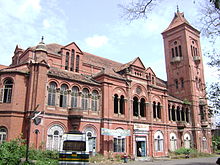Geography
Chennai is on the southeast coast of India in the northeast of Tamil Nadu on a flat coastal plain known as the Eastern Coastal Plains. Its average elevation is around 6.7 metres (22 ft), and its highest point is 60 m (200 ft). The Marina Beach runs for 12 km along the shoreline of the city. Two rivers meander through Chennai, theCooum River (or Koovam) through the centre and the Adyar River to the south. A third river, the Kortalaiyar, flows through the northern fringes of the city before draining into the sea at Ennore. Adyar and Cooum rivers are heavily polluted with effluents and waste from domestic and commercial sources. The state government periodically removes silt and pollution from the Adyar river, which is much less polluted than the Cooum. A protected estuary on the Adyar forms a natural habitat for several species of birds and animals. The Buckingham Canal, 4 km (2.5 mi) inland, runs parallel to the coast, linking the two rivers. The Otteri Nullah, an east-west stream, runs through north Chennai and meets the Buckingham Canal at Basin Bridge. Several lakes of varying size are located on the western fringes of the city. Red Hills, Sholavaram and Chembarambakkam Lake supply Chennai with potable water. Groundwater sources are becoming brackish.

Chennai is on a flat coastal plain, as shown on this Landsat 7 map. 
Satellite image of Chennai by NASA Landsat Chennai's soil is mostly clay, shale and sandstone. Sandy areas are found along the river banks and coasts, such as Thiruvanmiyur, Adyar, Kottivakkam, Santhome,George Town, Tondiarpet and the rest of coastal Chennai. Here rainwater runoff percolates quickly through the soil. Clay underlies most of the city including T. Nagar,West Mambalam, Anna Nagar, Villivakkam, Perambur and Virugambakkam. Areas of hard rock include Guindy, Perungudi, Velachery, Adambakkam and a part of Saidapet.[citation needed] Chennai is divided into four broad regions: North, Central, South and West. North Chennai is primarily an industrial area. Central Chennai is the commercial heart of the city and includes an important business district, Parry's Corner. South Chennai and West Chennai, previously mostly residential, are fast becoming commercial, home to a growing number of information technology firms, financial companies and call centres. The city is expanding quickly along the Old Mahabalipuram Road and the Grand Southern Trunk Road (GST Road) in the south and towards Ambattur, Koyambedu and Sriperumbdur in the west. Chennai is one of the few cities in the world that accommodates a national park, the Guindy National Park, within its limits.
Climate
Chennai has a tropical climate, specifically a tropical wet and dry climate. The city lies on the thermal equator[citation needed] and is also on the coast, which prevents extreme variation in seasonal temperature. The weather is hot and humid for most of the year. The hottest part of the year is late May to early June, known locally as Agni Nakshatram ("fire star") or as Kathiri Veyyil, with maximum temperatures around 38–42 °C (100–108 °F). The coolest part of the year is January, with minimum temperatures around 18–20 °C (64–68 °F). The lowest temperature recorded is 15.8 °C (60.4 °F) and highest 45 °C (113 °F) The average annual rainfall is about 140 cm (55 in). The city gets most of its seasonal rainfall from the north-east monsoon winds, from mid-October to mid-December. Cyclones in the Bay of Bengal sometimes hit the city. The highest annual rainfall recorded is 257 cm (101 in) in 2005. Prevailing winds in Chennai are usually southwesterly between April and October and northeasterly during the rest of the year.
| [hide]Climate data for Chennai |
|---|
| Month | Jan | Feb | Mar | Apr | May | Jun | Jul | Aug | Sep | Oct | Nov | Dec | Year |
|---|
| Average high °C (°F) | 28.4
(83.1) | 29.9
(85.8) | 31.9
(89.4) | 33.6
(92.5) | 36.4
(97.5) | 36.6
(97.9) | 34.7
(94.5) | 33.9
(93) | 33.5
(92.3) | 31.4
(88.5) | 29.2
(84.6) | 28.1
(82.6) | 32.3
(90.1) |
|---|
| Average low °C (°F) | 20.6
(69.1) | 21.2
(70.2) | 23.1
(73.6) | 25.9
(78.6) | 27.6
(81.7) | 27.2
(81) | 25.9
(78.6) | 25.3
(77.5) | 25.3
(77.5) | 24.3
(75.7) | 22.8
(73) | 21.6
(70.9) | 24.2
(75.6) |
|---|
| Rainfall mm (inches) | 16.2
(0.638) | 3.7
(0.146) | 3.0
(0.118) | 13.6
(0.535) | 48.9
(1.925) | 53.7
(2.114) | 97.8
(3.85) | 149.7
(5.894) | 109.1
(4.295) | 282.7
(11.13) | 350.3
(13.791) | 138.2
(5.441) | 1,266.9
(49.878) |
|---|
| Avg. rainy days | 1.0 | .3 | .2 | .7 | 1.6 | 4.1 | 7.3 | 8.5 | 6.6 | 10.2 | 10.1 | 5.5 | 56.1 |
|---|
| Sunshine hours | 269.7 | 271.2 | 294.5 | 291.0 | 279.0 | 204.0 | 186.0 | 192.2 | 198.0 | 195.3 | 183.0 | 204.6 | 2,768.5 |
|---|
| Source no. 1: WMO |
| Source no. 2: HKO (sun only, 1971–1990) |
Water
Historically, Chennai has relied on annual monsoon rains to replenish water reservoirs, as no major rivers flow through the area. With a steadily increasing population, the city has faced water supply shortages, and its ground water levels have been depleted. An earlier Veeranam Lake project failed to solve the city's water problems, but the New Veeranam project, which became operational in September 2004, has greatly reduced dependency on distant sources. In recent years, heavy and consistent monsoon rains and rainwater harvesting (RWH) by Chennai Metrowater at its Anna Nagar Rain Centre have significantly reduced water shortages. Moreover, newer projects like the Telugu Ganga project that bring water from water-surplus rivers like the Krishna River in Andhra Pradesh have eased water shortages. The city has constructed a sea water desalination plant to further increase the water supply.







